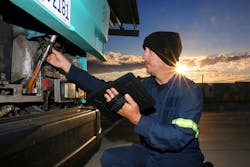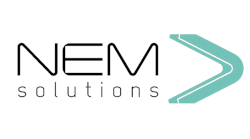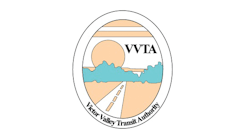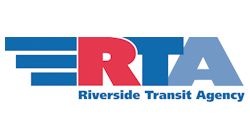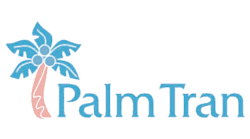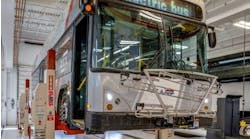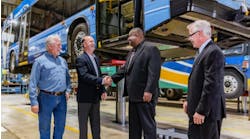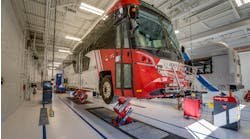Improving Efficiencies in Your Maintenance Department
Agencies and outside companies have found effective ways to manage maintenance departments. From ensuring safety, to keep operations on track, to making use of outside software to be used as a consultation for heads of department for training and diagnostics to keep maintenance departments running smoothly.
Palm Tran
"Toolbox Talks"
For administrative employees, congregations and discussions may occur around a water cooler. For maintenance staff, most conversations tend to be while rummaging through a toolbox for the perfect tool to complete the work. Therefore, Palm Tran's Maintenance Section decided to host formal meetings called "Toolbox Talks" at this frequently used informal location.
All maintenance employees, including managers, mechanics, paint and body specialists and parts room specialists are welcomed to be a part of these Toolbox Talks. Facilitated by Training and Technical Specialist Michael Lynch, the meeting is held at both the north and south Palm Tran maintenance garage locations on all shifts. Topics include safety, upcoming training opportunities, and current affairs at Palm Tran. The meetings are then opened up to maintenance staff to share information, concerns, and knowledge with each other.
Lasting anywhere from 10-20 minutes, Toolbox Talks are intended to be quick and brief, as not to disrupt employee workflow and take place every 30-45 days. The first meeting was held in May 2016 and was very well-received by staff. By keeping communication open, the safety and well-being of each and every maintenance employee is demonstrated to be a top priority.
Jim Moore
Vice President of Maintenance North America
National Express
Today’s mass transit buses are becoming more and more technologically advanced. Keeping up with the latest tools and software to perform comprehensive maintenance on electrical systems can be challenging, even for veteran technicians with extensive education and training. But, I’m a firm believer that if you know how something works, you can repair it.
To increase efficiency, diagnostic accuracy and keep our buses running smoothly, our teams at National Express are using the voltage drop test — an effective way to find bad connections in electrical circuits. Think of your car battery; if the car doesn’t start, it makes sense to check the battery terminals, cables and charge first.
Before replacing parts, a thorough check to make sure a strong electrical current is running to vital parts can save time and decrease cost.
- Starters—These rarely truly wear out. The most common damage occurs from low voltage, which leads to burned circuit contacts that will stop functioning.
- Alternators—High resistance in the charging circuit prevents the batteries from becoming fully charged. A domino effect happens when the batteries can’t supply the needed current to prevent damage to the starter.
- Flywheels—Six-cylinder engines stop in one of three positions every time. This causes the starter to engage the same few teeth each time it starts. Low voltage causes poor engagement and damaged teeth from the “chattering.”
Completing a voltage drop test before replacing parts is a first step that our team at National Express takes. When you invest in your technician’s knowledge and provide the best test equipment, you will benefit from quick and thorough repairs that increase uptime, eliminate rework and reduce cost.
Gorka Parada
Chief Revenue Officer
NEM Solutions
It all comes down to a humble and constructive approach that has five main pillars that will sustain the agency’s evolution towards efficiency: empowerment, external help, internal analysis, agency’s maintenance program roadmap and IT/Quality management.
Why do you need empowerment? Because you need someone to make decisions. This person (or group) must have the power to make decisions in order to make the program move forward. Middle ground will not work in this situation.
Once the empowerment has been achieved the first decision has to be to bring in external help. It is imperative that an unbiased point of view and a number of fresh ideas come into the equation. Transit agencies tend to have inertia and old habits that are very hard to break away from.
These are the three things that should be at the top of the list of things to do:
- Current situation assessment: it is of key relevance to really understand what the agency’s reality is. What is the real level of efficiency? How capable, or performing, are our resources? Is information shared? Is the agency organized in silos? Do the agency’s main stakeholders share goals and objectives? These aspects are very important to assess how functional/dysfunctional an agency is. Only by understanding how bad the situation really is there will be real chances of fixing it.
- Maintenance program roadmap: the final destination needs to be clear to everyone in the agency. Outlining the reasons why things are done, explaining the process and detailing the goals and benefits at the end of the process is a great way of bringing all stakeholders onboard.
- IT/Quality management: all this work and investment must guarantee that lasting benefits will be obtained. These benefits must transform the agency and for that the support of IT tools and processes will be of great help. The agency needs to generate knowledge and put it to good use. The only way to perpetuate and consolidate improvements is to embed them in the agency’s DNA.
At NEM Solutions we have been implementing this approach for years and the benefits have been outstanding.
Dustin Strandberg
Fleet Analysts
Victor Valley Transit Authority
Transit agencies may gain huge efficiencies through the use of a paperless fleet management (PFM) system. Switching to a paperless system provides quick and easy access to real time data of fleet information, current vehicle repairs, and vehicle history. The features of most PFM systems are capable of saving personnel hundreds of hours when reviewing work orders, preventative maintenance inspection (PMI) information, parts inventory, and repair history.
Many fleet management systems also offer paperless PMIs. Depending on the program, paperless PMI programs can produce auto-generated work orders for failed line items, enhancing accountability by ensuring failed items are resolved. Another benefit to the paperless PMI is quick access to data, which could include everything from tire tread depth specifications to the mileage between inspections.
Tablet technology may also be utilized with a PFM system. This provides technicians with one-touch access to vehicle- and component-specific shop manuals and historical maintenance data while on the go. It can also be used to easily perform PMIs, providing mechanics access to all pertinent vehicle data.
Making the switch to a paperless system should include a current and projected needs analysis. Utilizing the transit community is a great means of understanding real-world use cases and evaluating software options. Software demos are yet another way to understand how a program functions for a specific agency. The stability of the software developer, its business model, and industry-wide adoption of its software are important considerations.
Riverside Transit Agency
“Safety Milestone Reached”
The Riverside Transit Agency’s (RTA) Maintenance Department, which employs more than 60 mechanics, groundskeepers and supervisors at two facilities, achieved 1,000 days without a lost time injury. The achievement marked a safety milestone for RTA.
A lost-time accident is a job related injury that results in time away from work. In an effort to prevent injuries, RTA responds to safety suggestions, holds monthly safety committee meetings, and promotes safe practices in the workplace that include using caution around moving equipment and when moving around the facilities, particularly in adverse weather. RTA is also focused on maintaining a clean and organized workplace, which supervisors say promotes a safe work environment that prevents injuries.
Workplace injuries cost companies money in workers’ compensation claims and lost productivity. More than 400 RTA employees are covered by the workers’ compensation, which provides for medical treatment and loss of earnings that result from work-related injuries. With fewer workplace injuries, RTA is able to focus its attention and resources on the business of public transportation.
